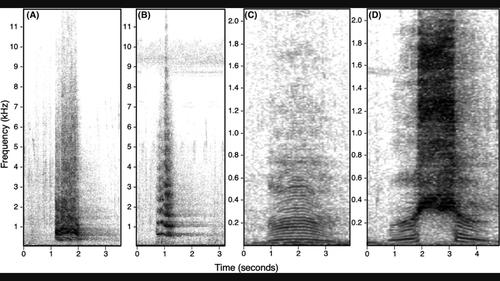被动声学监测中目标信号选择的影响:以非洲森林象(Loxodonta cyclotis)的声带使用为例,说明其年龄和性别依赖性
IF 3.9
2区 环境科学与生态学
Q1 ECOLOGY
引用次数: 0
摘要
被动声学监测(PAM)是一种有效的遥感方法,可对声学活跃的动物物种进行采样,尤其适用于栖息在偏远或难以进入的生境中的难以捉摸、视觉隐蔽的物种。声学监测的主要优势是空间覆盖范围大和可进行连续、长期监测。在大多数情况下,利用信号检测算法在长序列音频数据中定位感兴趣的声音。在选择用于检测的特定信号时,了解鸣叫类型的人口/环境使用情况非常重要。如果取样仅限于种群的子集,例如,只有某个人口统计类别才会发出可探测的叫声,则可能会导致取样偏差。我们以非洲森林象的叫声为案例,检验了不同年龄-性别类别之间在使用叫声类型方面的差异。我们发现不同年龄-性别的大象对四种叫声--吼声、喇叭声、隆隆声和组合叫声--的使用不成比例。这种按人口统计等级划分的信号使用差异对该物种在PAM中使用特定呼叫类型具有影响。我们的研究结果突出表明,使用隆隆声作为目标信号的森林象PAM研究可能对成年雄象取样不足。在 PAM 框架中添加其他类型的叫声可能有助于从这些调查中获得更多的种群人口信息。我们的研究举例说明了如何利用对物种声学行为的研究来更好地理解 PAM 的数据和结果,并加强由此得出的推论。本文章由计算机程序翻译,如有差异,请以英文原文为准。

Implications of target signal choice in passive acoustic monitoring: an example of age- and sex-dependent vocal repertoire use in African forest elephants (Loxodonta cyclotis)
Passive acoustic monitoring (PAM) is an effective remote sensing approach for sampling acoustically active animal species and is particularly useful for elusive, visually cryptic species inhabiting remote or inaccessible habitats. Key advantages of PAM are large spatial coverage and continuous, long-term monitoring. In most cases, a signal detection algorithm is utilized to locate sounds of interest within long sequences of audio data. It is important to understand the demographic/contextual usage of call types when choosing a particular signal to use for detection. Sampling biases may result if sampling is restricted to subsets of the population, for example, when detectable vocalizations are produced only by a certain demographic class. Using the African forest elephant repertoire as a case study, we test for differences in call type usage among different age-sex classes. We identified disproportionate usage by age-sex class of four call types—roars, trumpets, rumbles, and combination calls. This differential usage of signals by demographic class has implications for the use of particular call types in PAM for this species. Our results highlight that forest elephant PAM studies that have used rumbles as target signals may have under-sampled adult males. The addition of other call types to PAM frameworks may be useful to leverage additional population demographic information from these surveys. Our research exemplifies how an examination of a species' acoustic behavior can be used to better contextualize the data and results from PAM and to strengthen the resulting inference.
求助全文
通过发布文献求助,成功后即可免费获取论文全文。
去求助
来源期刊

Remote Sensing in Ecology and Conservation
Earth and Planetary Sciences-Computers in Earth Sciences
CiteScore
9.80
自引率
5.50%
发文量
69
审稿时长
18 weeks
期刊介绍:
emote Sensing in Ecology and Conservation provides a forum for rapid, peer-reviewed publication of novel, multidisciplinary research at the interface between remote sensing science and ecology and conservation. The journal prioritizes findings that advance the scientific basis of ecology and conservation, promoting the development of remote-sensing based methods relevant to the management of land use and biological systems at all levels, from populations and species to ecosystems and biomes. The journal defines remote sensing in its broadest sense, including data acquisition by hand-held and fixed ground-based sensors, such as camera traps and acoustic recorders, and sensors on airplanes and satellites. The intended journal’s audience includes ecologists, conservation scientists, policy makers, managers of terrestrial and aquatic systems, remote sensing scientists, and students.
Remote Sensing in Ecology and Conservation is a fully open access journal from Wiley and the Zoological Society of London. Remote sensing has enormous potential as to provide information on the state of, and pressures on, biological diversity and ecosystem services, at multiple spatial and temporal scales. This new publication provides a forum for multidisciplinary research in remote sensing science, ecological research and conservation science.
 求助内容:
求助内容: 应助结果提醒方式:
应助结果提醒方式:


